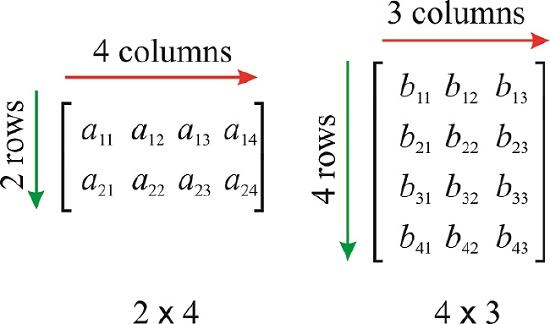15.1: Definitions
- Page ID
- 106896
An \(m\times n\) matrix \(\mathbf{A}\) is a rectangular array of numbers with \(m\) rows and \(n\) columns. The numbers \(m\) and \(n\) are the dimensions of \(\mathbf{A}\). The numbers in the matrix are called its entries. The entry in row \(i\) and column \(j\) is called \(a_{ij}\).

Some types of matrices have special names:
- A square matrix:\[\begin{pmatrix} 3 &-2 &4 \\ 5 &3i &3 \\ -i & 1/2 &9 \end{pmatrix} \nonumber\] with \(m=n\)
- A rectangular matrix:\[\begin{pmatrix} 3 &-2 &4 \\ 5 &3i &3 \end{pmatrix}\nonumber\] with \(m\neq n\)
- A column vector:\[\begin{pmatrix} 3 \\ 5\\ -i \end{pmatrix}\nonumber\] with \(n=1\)
- A row vector:\[\begin{pmatrix} 3 &-2 &4 \\ \end{pmatrix}\nonumber\] with \(m=1\)
- The identity matrix:\[\begin{pmatrix} 1 &0 &0 \\ 0 &1 &0 \\ 0&0 &1 \end{pmatrix}\nonumber\] with \(a_{ij}=\delta_{i,j}\), where \(\delta_{i,j}\) is a function defined as \(\delta_{i,j}=1\) if \(i=j\) and \(\delta_{i,j}=0\) if \(i\neq j\).
- A diagonal matrix:\[\begin{pmatrix} a &0 &0 \\ 0 &b &0 \\ 0&0 &c \end{pmatrix}\nonumber\] with \(a_{ij}=c_i \delta_{i,j}\).
- An upper triangular matrix:\[\begin{pmatrix} a &b &c \\ 0 &d &e \\ 0&0 &f \end{pmatrix}\nonumber\] All the entries below the main diagonal are zero.
- A lower triangular matrix:\[\begin{pmatrix} a &0 &0 \\ b &c &0 \\ d&e &f \end{pmatrix}\nonumber\] All the entries above the main diagonal are zero.
- A triangular matrix is one that is either lower triangular or upper triangular.
The Trace of a Matrix
The trace of an \(n\times n\) square matrix \(\mathbf{A}\) is the sum of the diagonal elements, and formally defined as \(Tr( \mathbf{A})=\sum_{i=1}^{n}a_{ii}\).
For example,
\[\mathbf{A}=\begin{pmatrix} 3 &-2 &4 \\ 5 &3i &3 \\ -i & 1/2 &9 \end{pmatrix}\; ; Tr(\mathbf{A})=12+3i \nonumber\]
Singular and Nonsingular Matrices
A square matrix with nonzero determinant is called nonsingular. A matrix whose determinant is zero is called singular. (Note that you cannot calculate the determinant of a non-square matrix).
The Matrix Transpose
The matrix transpose, most commonly written \(\mathbf{A}^T\), is the matrix obtained by exchanging \(\mathbf{A}\)’s rows and columns. It is obtained by replacing all elements \(a_{ij}\) with \(a_{ji}\). For example:
\[\mathbf{A}=\begin{pmatrix} 3 &-2 &4 \\ 5 &3i &3 \end{pmatrix}\rightarrow \mathbf{A}^T=\begin{pmatrix} 3 &5\\ -2 &3i\\ 4&3 \end{pmatrix} \nonumber\]


